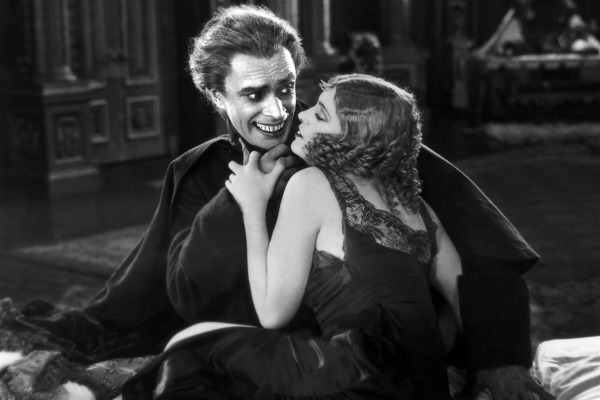The Man Who Laughs: The Movie That Inspired Batman’s Joker (Sort of) Turns 86
Now you'll know how he got his scars.

Halloween may be over, but that doesn’t mean you have to pack away your love for the creepy and macabre until the New Year. Rejoice! For today marks the 86th anniversary of the release of The Man Who Laughs, a movie simultaneously twisted, disturbing, and utterly, squeeably adorable.
The 1928 silent film, about a man with an exceptionally unsettling disfigurement, is best known to contemporary cinephiles and comic book readers as The Movie That Inspired Batman’s Joker. And, indeed, it is. Or, at least, its protagonist is. In a 1994 interview, Batman creator, Bob Kane, explained:
Bill Finger and I created the Joker. Bill was the writer. Jerry Robinson came to me with a playing card of the Joker. That’s the way I sum it up. But he looks like Conrad Veidt – you know, the actor in The Man Who Laughs… So Bill Finger had a book with a photograph of Conrad Veidt and showed it to me and said, “Here’s the Joker.”
As happy as I am that this origin story may get folks otherwise uninterested in silent film to check out The Man Who Laughs (in all honesty, that’s how I first heard about it), that shouldn’t be this movie’s sole legacy. Beneath the intertextuality, The Man Who Laughs is an absolute gem all on its own.
Based on Victor Hugo’s novel L’Homme Qui Rit, The Man Who Laughs tells the tale of Gwynplaine, a man who had a permanent smile carved into his face as a child as punishment for having a rebel-rousing nobleman for a father. Deformed, he now works in a traveling circus and is in a relationship with a blind woman named Dea. Matters get complicated when the femme fatale Duchess Josiana takes a perverse fancy to him and the Queen learns of Gwynplaine’s noble lineage.
Admittedly, the premise, apart from the, uh, facial deformity bit, isn’t anything exceptional. A story about an ugly man in love with a beautiful woman was probably already overdone in 1928 and the plot is littered with logical leaps and loopholes the most bothersome of which occurs around the midpoint. Gwynplaine feels unworthy of Dea’s love, because she’s blind and therefore doesn’t realize how ugly he is. So, he accepts an invitation to meet the Duchess Josiana in her bedchambers, rationalizing that if a sighted woman can look upon his face and still love him, then he “[has] the right to marry Dea.”
Um… I… eh…
What’s worse is that, when this elaborate justification for infidelity goes afoul and Josiana laughs at him, Gwynplaine returns home to the circus and Dea takes him back, no questions asked. Gwynplaine never apologizes and Dea (who really could be replaced with a sexy lamp at no expense to the script) never broaches the topic again. Under normal circumstances such an oversight would ruin a movie for me, but here’s the thing: Gwynplaine and Dea’s reunion is so sweet that I DON’T CARE ABOUT THE SLOPPY WRITING. Every time I watch it I’m too distracted by the warmth in my heart and the realization that I am hugging myself and rocking from side to side to be critical.
In other words, what makes this movie work isn’t the story it tells, but how it tells it. The art direction drips with gothic goodness and, though The Man Who Laughs was an American film, it features all the crooked lines and long shadows characteristic of German Expressionism (which makes sense, since director, Paul Leni, was a major figure in that movement).
This dark atmosphere clashes deliciously with the warmth within the circus family unit, which is where the heart of the film lies. Conrad Veidt… *sigh*
Conrad Veidt plays Gwynplaine with such intensity and care that you forget that he’s sort of cliché. And, though I wish Dea had more development, she and Gwynplaine still make one of the sweetest on-screen couples in the history of celluloid. Their relationship is chaste and their interaction innocent by modern standards, but their love for one another is so palpable during their many snuggle sessions that one can’t help but envy their relationship.
So, do what you must to get your hands on this movie. It may be older than your grandma but, in this age of technology, it is available for viewing. Get it on Netflix, YouTube, or order it on DVD, and enjoy how this underrated classic marries the bizarre and the conventional, the unsettling and sweet, as few movies can.
Petra Halbur is an undergraduate at Hofstra University pursuing a BA in journalism and presently trapped in the world-building phase of writing her science-fantasy novel. You can read more from her at Ponderings of a Cinephile or follow her on Twitter.
Are you following The Mary Sue on Twitter, Facebook, Tumblr, Pinterest, & Google +?
Have a tip we should know? tips@themarysue.com